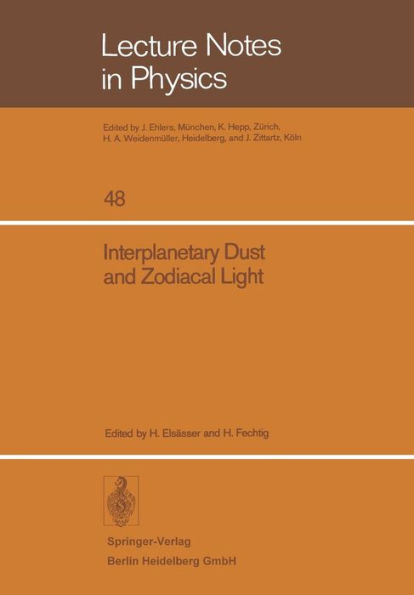5
1

Interplanetary Dust and Zodiacal Light: Proceedings of the IAU-Colloquium No. 31, Heidelberg, June 10-13, 1975
501
by H. Elsïsser (Editor), H. Fechtig (Editor)
H. Elsïsser

Interplanetary Dust and Zodiacal Light: Proceedings of the IAU-Colloquium No. 31, Heidelberg, June 10-13, 1975
501
by H. Elsïsser (Editor), H. Fechtig (Editor)
H. Elsïsser
Paperback(1976)
$109.99
-
PICK UP IN STORECheck Availability at Nearby Stores
Available within 2 business hours
Related collections and offers
109.99
In Stock

Product Details
| ISBN-13: | 9783540076155 |
|---|---|
| Publisher: | Springer Berlin Heidelberg |
| Publication date: | 06/09/1976 |
| Series: | Lecture Notes in Physics , #48 |
| Edition description: | 1976 |
| Pages: | 501 |
| Product dimensions: | 6.69(w) x 9.61(h) x (d) |
Table of Contents
Space observations of the zodiacal light.- Helios zodiacal light experiment.- Preliminary results of the helios a zodiacal light experiment.- Pioneer 10 observations of zodiacal light brightness near the ecliptic: Changes with heliocentric distance.- Star counts in the background sky observed from pioneer 10.- The S10 (V) unit of surface brightness.- Polarization of the zodiacal light: first results from skylab.- Photometry of the zodiacal light with the balloon — borne telescope thisbe.- OSO-5 Zodiacal Light Measurements 1969–1975.- Evidence for scattering particles in meteor streams.- The ultraviolet scattering efficiency of interplanetary dust grains.- Summary of observations of the solar corona/inner zodiacal light from Apollo 15, 16, and 17.- A temporal study of the radiance of the F-corona close to the sun.- Measurements of the T-corona from daily OSO=7 observations.- The thermal emission of the dust corona during the eclipse of June 30, 1973.- The color characteristics of the earth-moon libration clouds.- A search for forward scattering of sunlight from the lunar libration clouds.- Presemtation of Zodiacal Light instrument aboard the D2B astronomical satellite.- Visible and UV photometry of the gegenschein and the milky way.- Ground-based observations of the zodiacal light.- Polarimetry of the zodiacal light and milky way from Hawaii.- Scattering in the earth's atmosphere: Calculations for milky way and zodiacal light as extended sources.- Scattering layer of cosmic dust in the upper atmosphere.- Some formulae to interpret zodiacal light photopolarimetric data in the ecliptic from ground or space.- Discussion of the rocket photometry of the zodiacal light.- Consequences of the inclination of the zodiacal cloud on the ecliptic.- Method for the determination of the intensity of scattered sunlight per unit-volume of the interplanetary medium.- On the visibility of the libration clouds.- Scattering functions of dielectric and absorbing irregular particles.- The compatibility of recent micrometeoroid flux curves with observations and models of the zodiacal light.- In-situ records of interplanetary dust particles — methods and results.- Preliminary results of the micrometeoroid experiment on board helios A.- Composition of impact-plasma measured by a HELIOS-micrometeoroid-detector.- Orbital elements of dust particles intercepted by pioneers 8 and 9.- Flux of hyperbolic meteoroids.- The cosmic dust environment at earth, jupiter and interplanetary space results FRO, Langley experiments on MTS, Pioneer 10, and Pioneer 11.- Dust in the outer solar system - review of early results from Pioneers 10 and 11.- Sources of interplanetary dust: Asteroids.- Lunar microcraters and interplanetary dust fluxes.- The size frequency distribution and rate of production of microcraters.- The long term population of interplanetary micrometeoroids.- Lunar soil movement registerd by the apollo 17 cosmic dust experiment.- lectrostatic disruption of lunar dust particles.- Microcraters produced by oblique incidence of projectiles.- Measurements of Impact Ejecta Parameters in Crater Simulation Experiments.- Impact light flash studies: Temperature, Ejecta, Vaporization.- Submicron Particles from the Sun.- Analysis of impact craters from the S-149 Skylab experiment.- Micrometeorite impact craters on Skylab EXPERIMENT S-149.- Extraterrestrial particles in the stratosphere.- Magellan collections of large cosmic dust particles.- Specific sources of extraterrestrial particles.- Near-earth fragmentation of cosmic dust.- Dust in comets and interplanetary matter.-The production rate of dust by comets.- Can short period comets maintain the zodiacal cloud?.- Optical properties of cometary dust.- The dust coma of comets.- Dust emission from Comet Kohoutek (1973f) at large distances from the sun.- Predicted favorable visibility conditions for anomalous tails of comets.- Study of the anti-tail of Comet Kohoutek from an observation on 17 January 1974.- Condensation processes in high temperature clouds.- Mariner mission to Encke 1980.- Meteors and interplanetary dust.- Meteoroid densities.- Possible evidence of meteoroid fragmentation in interplanytary space from grouping of particles in meteor streams.- The heliocentric distribution of the meteor bodies at the vicinity of the earth's orbit.- Fireballs as an atmospheric source of meteoritic dust.- Interplanetary dust in the vicinity of the earth.- Meteor radar rates and the solar cycle.- Evolution and detectability of interplanetary dust streams.- On the structure of hyperbolic interplanetary dust streams.- Expected distribution of some of the orbital elements of interstellar particles in the solar system.- Sources of interplanetary dust.- Dynamics of interplanetary duest and related topics.- Modeling of the orbital evolution of vaporizing dust particles near the sun.- Orbital evolution of circum-solar dust grains.- Temperature distribution and lifetime of interplanetary ice grains.- Radial distribution of meteoric particles in interplanetary space.- Rotational bursting of interplanetary dust particles.- Lunar ejecta in heliocentric space.- Radiation pressure on interplanetary dust particles.- Are interplanetary grains crystalline?.- A Technique for measuring the interstellar component of cosmic dust.- The zodiacal light.- In situ measurements of dust.- Can comets be the only source of interplanetary dust?.- Meteors.- Final remarks.From the B&N Reads Blog
Page 1 of
